November 15 - 21, 2020: Issue 474
Marine Rescue Broken Bay Unit's Beginnings In The Volunteer Coastal Patrol - Some RMYC BB Connections
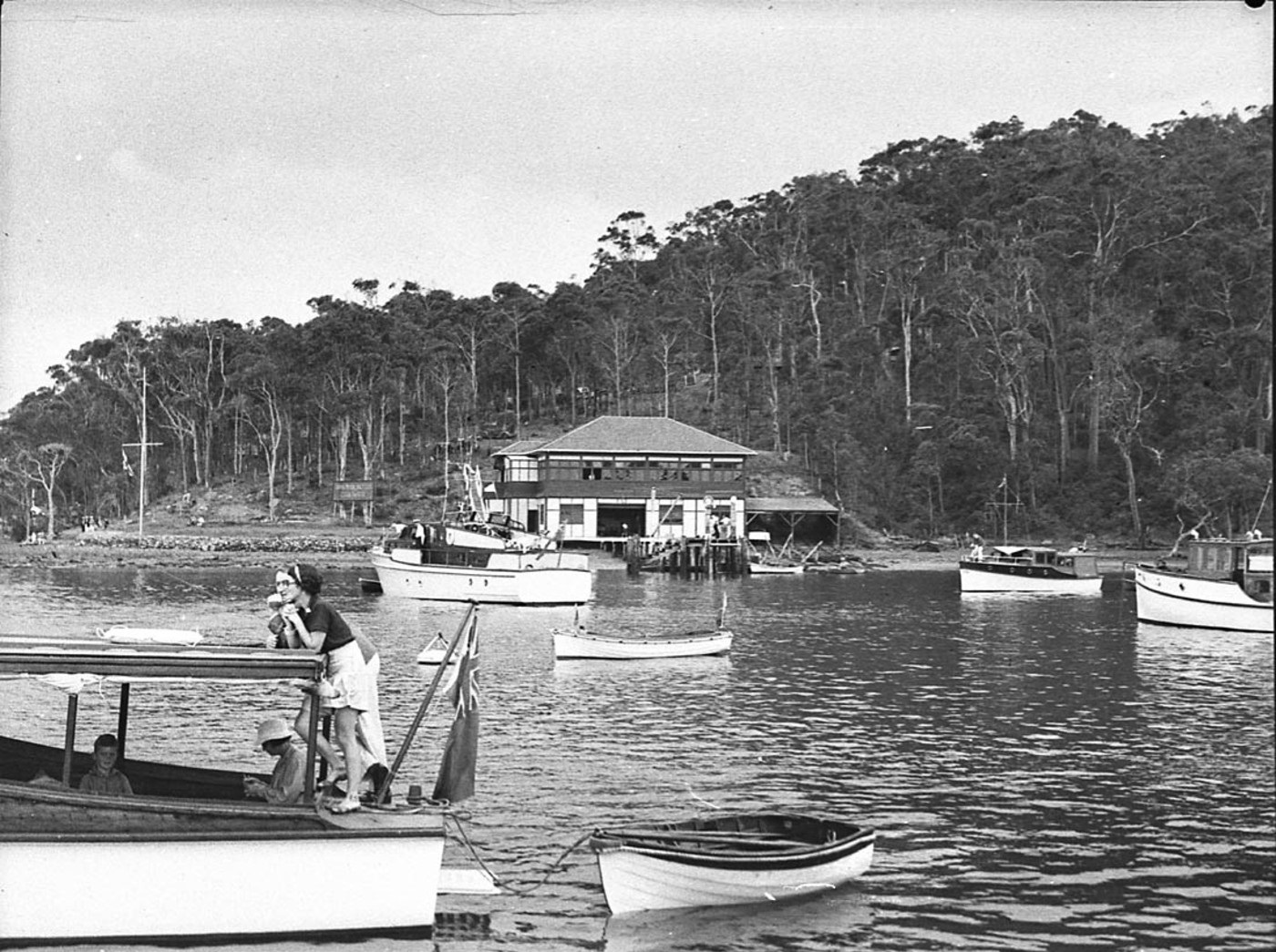
November each year is a special month for the Marine Rescue Broken Bay unit (at Bayview), as it was in this month that the original unit was formed as the Volunteer Coastal Patrol, making this month in 2020 the 84th year in a row volunteers have served the local and visiting boating community.
In November 2012 the unit celebrated its 75th anniversary with the launch of long-standing member David Harrison with a craft named for him - the David B Harrison. David joined the then named Royal Volunteer Coastal Patrol in May 1974. In 2012 Pittwater Online asked Mr Harrison, who was wearing the Centennial Medal, a National Medal for Community Service and his 30+ years Long Service Medal for Marine Rescue to share a few memorable moments from his decades of volunteer service in Marine Rescue;
“Years ago Chris Cardiff-Jones of the Canoe Association asked us to provide our safety vessels for the canoe race from Windsor to Brooklyn. This was done at night time. it is now in its 37th year with over 500 paddlers raising money for charity. It started from nothing and now is known worldwide as the Hawkesbury Canoe Classic. So it was great to support that.
The other memorable achievement was forming the Royal Volunteers Coastal Patrol’s Education Board; setting up education training for members and purchasing the vessel the 'Harold Nobbs', named after one of our original Division Commanders, on which we trained many for 10-15 years. The Yacht Federation were trained through that, the Coast Guard, TAFE students and our selves. “
How did you first get involved with BBMR sir?
“We used to come down here and fish off the coast. These folk always asked us where we were going and when we’d be back. After so many years and seeing all the great work they do we decided it was time to put something back in, so myself and Margaret’s dad, who was already in it, came here thereafter.”
On Saturday November 14th, 2020 the official naming ceremony and launch of the Marine Rescue Broken Bay New BB30, the Michael Seale, took place at the RMYCBB with MP for Pittwater and NSW Minister for the Department of Planning, Industry and Environment, Rob Stokes, NSW Minister for Police and Emergency Services David Elliott and Marine Rescue NSW Commissioner Stacey Tannos to officially welcome the new vessel, Broken Bay 30, to the MRNSW fleet. The Michael Seale arrived in Pittwater on Wednesday morning, July 29th. It is a 10 metre Naiad constructed by Yamba Welding and Engineering and is fitted with twin 300HP Suzuki outboards and an 800 litre fuel tank.
MRNSW Commissioner Stacey Tannos said the new vessel replaced an older boat reaching the end of its operational life, also Broken Bay 30, which was the first boat to wear the new MRNSW livery when the single unified service was established in 2009. The old BB30 was given the honorary name of Peter E Weston, and was named after a prominent member of the Broken Bay Unit, Peter Weston. Peter also held executive positions within the then Royal Volunteer Coastal Patrol.
Michael Seale has formerly served as Chairman of the Board of Royal Volunteer Coastal Patrol and has been a long term member of Marine Rescue Broken Bay, serving as Deputy Unit Commander and fulfilling various other roles within the volunteer organisation. The Royal Volunteer Coastal Patrol and the Australian Volunteer Coast Guard Association commenced merging to form Marine Rescue NSW in July 2009, with 2020 marking 10 years since the members took to the water and the airwaves as a new, unified service on January 1st, 2010. His Royal Highness The Prince of Wales is the Patron-in-Chief of Marine Rescue NSW.
The Broken Bay unit also has a long association with the Royal Motor Yacht Club of Broken Bay (at Newport), which provided a room for members to meet in for years prior to a station and radio room being established at Bayview, and prior to that, drew on early members of the RMYCBB to form the Volunteer Coastal Patrol Broken Bay unit in 1937. Originally a branch of the Motor Yacht Club of NSW, Rose Bay, whose patron was Governor Sir Dudley de Chair, the gentleman who was instrumental in securing the ‘Royal’ prefix by King George V, members had spent time in Pittwater for years before the first RMYCBB clubhouse being opened in March 1928.
Being able to defend Pittwater and the view that Broken Bay could be used as an inroad by invaders had been discussed for decades prior to this, the training exercises of The Wolverne here in 1885, along with the recommendations in the 1887 report by Major-General Schaw, were the commencement of not only having an on-water crew of trained and skilled people able to defend this place but also having the capacity to respond to incidents and be able to rescue others. After the closure of the Customs Station at Broken Bay (Station Beach, Barrenjoey) and the shift from Barrenjoey Lighthouse from a manned to unmanned system, resident fishermen were the ones often called on to go to the aid of those in peril at sea - the Goddards, Gonsalves, Verrills, and Carl Gow. Even after the commencement of the Broken Bay Water Police in 1966, the Volunteer Coastal Patrol, now Marine Rescue NSW, has followed and maintained its primary objective - Safety of Life at Sea (SOLAS).
Sir Dudley Rawson Stratford de Chair became governor of New South Wales in October 1923, arriving in Sydney with his wife on February 28 1924. He was a naval gentleman prior to being a NSW Governor. In 1915-16, as rear admiral commanding the tenth cruiser squadron, he was responsible for the effective North Sea blockade of Germany. He was appointed K.B.E in 1916 and took command of the Coast Guard in England in 1918.
After arriving in New South Wales he held the Royal Motor Yacht Club at Broken Bay in high esteem and attended many of their regattas, races and social functions, especially Awards Ceremonies. This is a RMYC Broken Bay tradition that is still honoured as witnessed at the opening of the boating season 2012-13 with Rear Admiral Davyd Thomas, AO, CSC, RAN (Rtd.) attending and giving the keynote address.
In 1927 land was purchased at Horseshoe Cove, Newport so a more permanent berth could be built.
ROYAL MOTOR YACHT CLUB.
At the first annual meeting of the Broken Bay branch of the Royal Motor Yacht Club of New South Wales, Mr A C Cooke was re-elected branch commodore, Mr H J Fitzpatrick vice commodore and Mr T B Rossiter rear commodore. Since its first event on November 20 last, the branch decided 25 races including 8 for ladies and the prizes were decided between 11 boats. The branch has purchased a site for a clubhouse in Horseshoe Cove, Newport, and the building, together with a jetty and slips, will be ready for occupation in December. The branch had a return of income over expenditure of 98 pounds for its first year’s operations. NOTES. (1927, September 6). The Sydney Morning Herald(NSW : 1842 - 1954), p. 7. Retrieved March from http://nla.gov.au/nla.news-article16401852
Newport.-Construction of jetty and slips for motor yacht club. Mr. F. Winn, architect, 2 Hunter-street. TENDERS. (1927, August 24). The Sydney Morning Herald(NSW : 1842 - 1954), p. 9. Retrieved from http://nla.gov.au/nla.news-article28053346
The official opening of this first clubhouse took place on 17th March 1928. Around the same time, and ten years before the Volunteer Coastal Patrol was first formed, the idea to support this was evident in Pittwater:
MOTOR YACHTS. A SUCCESSFUL SEASON.
GOVERNOR DISTRIBUTES PRIZES.
His Excellency the Governor (Sir Dudley de Chair) last night presented last season's prizes to members of the Royal Motor Yacht Club of New South Wales. The Commodore (Mr Stuart Doyle) remarked that the season had been a record for the club. Fifty-seven races were held in Rose Bay and 25 at Pittwater with the Broken Bay branch. Altogether 185 prizes were distributed. The club had doubled its membership, and, in this, its twenty-second year, had attained manhood. The branch commodore (Mr A C Cooke)said that the Broken Bay Club, although only nine months old, had collected nearly 100 members, building a club-house at Newport on the shores of Pittwater.
Sir Dudley de Chair praised the work motor yachtsmen had performed in the war, and exhorted members of the Royal Motor Yacht Club to attend the lectures on naval training and work which the club was arranging. MOTOR YACHTS. (1927, August 5). The Sydney Morning Herald (NSW : 1842 - 1954), p. 12. Retrieved March from http://nla.gov.au/nla.news-article16395007
In naval circles an organisation such as the Royal Motor Yacht Club is regarded as possible of conversion into a valuable auxiliary service in time of war, and in this connection the craft are often referred to as the "mosquito fleet." On Saturday, however, a more imposing impression was created as the ceremonial procession of visiting cruisers swept past the flagship of Branch Commodore A. D. Walker, of Broken Bay. The fleet was led by Miramar II, and advanced in line astern from a point near the entrance to the bay, creating the impression of a line of destroyers. As Miramar II. went past Lolita, the Broken Bay flagship, Commodore Stuart F. Doyle greeted Branch Commodore Walker with a salute of 11 guns, and received a similar courtesy from the after deck of Lolita. As each visiting ship passed flags were dipped in true naval style.
At the conclusion of the races late in the afternoon, members and their guests gathered in the club-house for the annual dinner of the branch, after which the presentation of prizes took place. Many valuable trophies were presented, including a plaque of life membership of the branch to Commodore Stuart F. Doyle. Branch Commodore Walker announced that he intended to present a trophy for an ocean race from Broken Bay to Toronto, head-quarters of the Newcastle branch. Branch Commodore Charles Bacon and Rear-Commodore Lance Lawson, of Newcastle, Vice-Commodore R. Smith, of the Australian Motor Yacht Squadron, and Mr. E. C. Griffith, president of the Australasian Power Boat Association, were among the guests. Results are published on our sporting rages. MOTOR YACHT CLUB. (1933, October 9). The Sydney Morning Herald (NSW : 1842 - 1954), p. 12. Retrieved from http://nla.gov.au/nla.news-article17013956
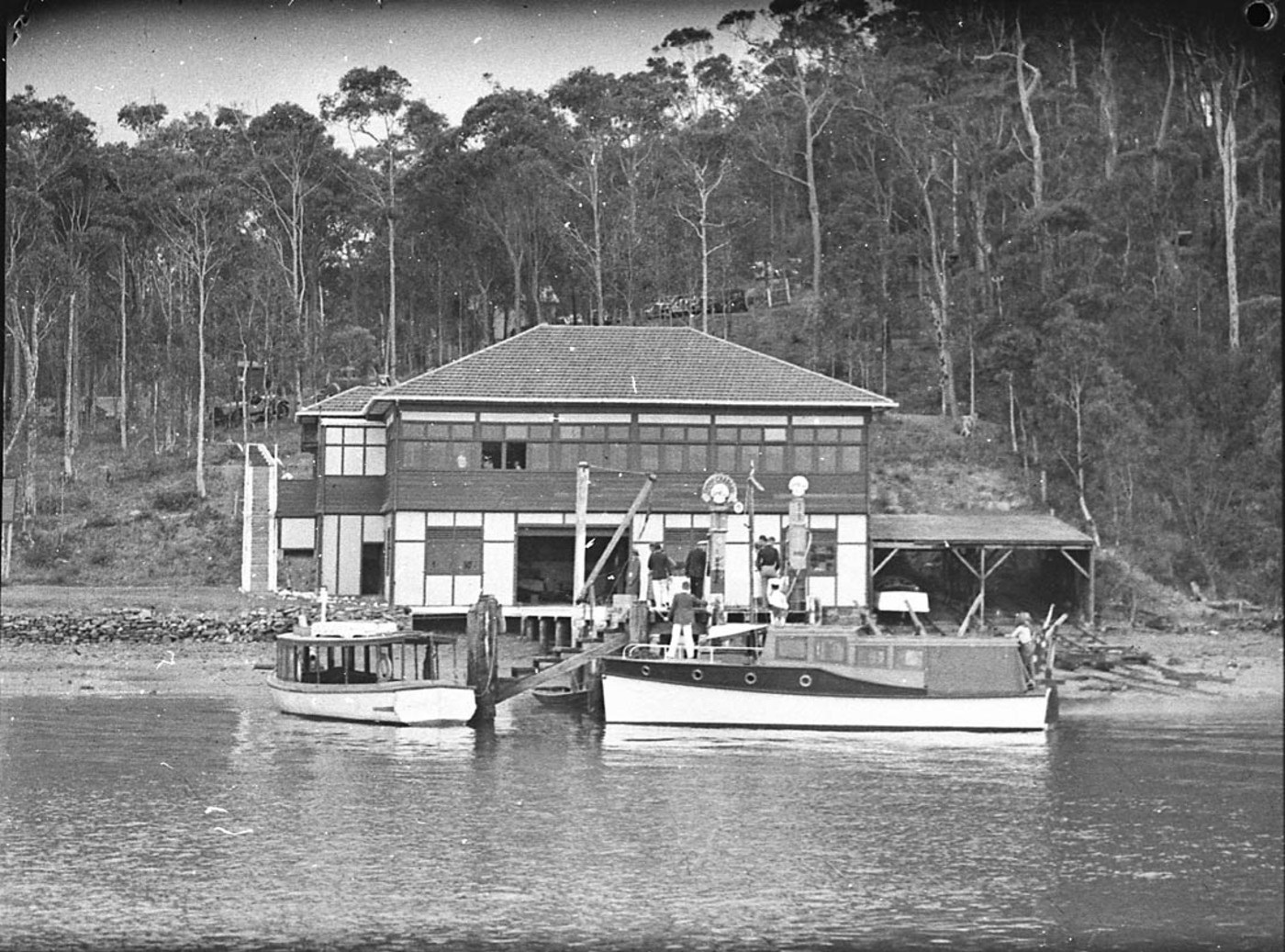
Above: Second RMYC Clubhouse on waterfront, December 1936 - Courtesy State Library of NSW, hood_13593h
Coastal Patrol, the oldest voluntary sea rescue organisation in Australia, evolved from discussions between Captain Maurice Blackwood DSO RN and Messrs. H W G Nobbs and W Giles. These men worked on the idea and submitted it to friend and colleague, CMDR Rupert Long OBE, Director of Naval Intelligence.
The concept of using experienced merchantmen and yachtsmen as an auxiliary service to the Navy and Government maritime authorities was first used in Britain at the turn of the century. Later in both Great Wars, British servicemen who had marine or yachting experience were taken out of the ranks and placed in small ship service. The use of small ships in both peace and war had been invaluable. With Australia’s 12,000 nautical mile coastline, the four men believed that an organisation of volunteer yachtsmen, many of whom were experienced merchant and naval seamen, would be extremely beneficial.
Commander Long recommended to the Naval Board that an organisation, to be called the Volunteer Coastal Patrol, be established. The Naval Board agreed to the concept. The Volunteer Coastal Patrol was started on 27th March, 1937. At the Navy’s suggestion and supported by CMDR Long, Maurice Blackwood DSO RN was the first Commanding Officer with Harold Nobbs and Bill Giles as the senior officers.
The original aims and objectives were issued in a handbook:
- To encourage the volunteer service of yachtsmen and others interested in seamanship to undergo a course of training so that, in the event of a national emergency, the service would be of value to the Royal Australian Navy or the military forces as may be required.
- To place at the disposal of the Movement their vessels (provided that they are of suitable type) for use in training, as may be needed, but always in charge of the owner-skipper.
- The course of training will be that laid down by the Senior Officer of the Movement and meeting with the approval of the Naval authorities if required.
- The headquarters of the Movement will be at any place to be decided by the Senior Officers.
It is interesting to note that the Patrol was referred to as ‘A movement’ in these early days. An organisational structure, discipline, ranks and bases were set out in the handbook:
- The Movement shall be under the direction and absolute control of the Senior Officers, who will be responsible for carrying out the administration of the rules governing the unit as set down, assisted by a staff appointed by the Senior Officers as are required.
- The personnel shall consist of: Boat owners (rank, Skipper) Flotilla Skippers, Divisional Skippers, Mates, Wireless Mates holding WIT licences
- Or any other rank for specialists that may be decided necessary by their Senior Officers. The Units will be formed in the various ports as opportunities occur, and in each port a Divisional Skipper will be appointed and, on attaining Flotilla strength of sixteen ships (4 Divisions), a Flotilla Skipper will take command.
- All applications for enrolment shall be made on the forms available and be subjected to inspection or examination by the examiner as required by the Movement.
Training was taken from Admiralty courses, enabling members to progress to higher ranks. Members would donate the use of their boats to the Coastal Patrol. The instructors in those early days were Naval personnel who donated their off-duty hours to train the members.
The moment war was declared in 1939, the Navy requested Captain Blackwood to establish the Patrol’s attitude to serving in war. Captain Blackwood called a meeting at the Navy League, High Street, Neutral Bay, at which the fifty members of the Patrol reaffirmed their desire to serve their country as a volunteer service.
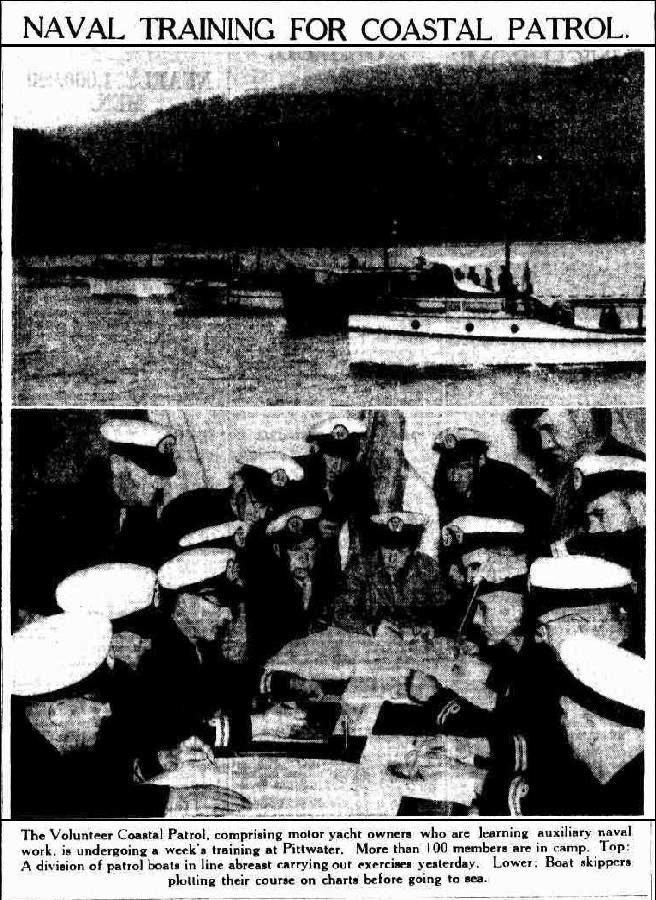 Then followed a period of rapid expansion during which time, Captain Blackwood retired as CO to become a Commodore of Convoys, he was followed by H W G Nobbs with the altered title of Officer Commanding.
Then followed a period of rapid expansion during which time, Captain Blackwood retired as CO to become a Commodore of Convoys, he was followed by H W G Nobbs with the altered title of Officer Commanding.
The first task in 1939 allotted to Coastal Patrol was to establish a security watch on the Hawkesbury River Rail Bridge.
Training was stepped up with the inclusion of courses from the Maritime Services Board and Police Department on fire fighting, air raids, oil spillage in the Harbour and the general security of port facilities.
In November 1939, one hundred members moved to The Basin, Pittwater, Broken Bay for eight days of intensive training on signals, aircraft recognition, boat handling and security patrol duty.
The camp was inspected by General Sturdee (Eastern Command), Brigadier-General J J Murray, Colonel Adrian and Captain Nobbs, (father of the OC of the Coastal Patrol).
As a result of this closer co-operation with the Army, Patrol boats were used to establish more accurate military maps of the coastline, with particular attention to beach defences.
The Army had given this task to Captain Bill Bowe of the Military Survey.
COASTAL PATROL. Volunteer Defence Move.
A movement in Sydney for the formation of a Volunteer Coastal Patrol is expected to spread to all States.
The owners of many vessels in Sydney ranging from large auxiliary yachts to small speed boats have undertaken to place themselves unreservedly at the service of the Royal Australian Navy if the necessity arises.
Owners will use their own boats under their own command. The craft will be formed into flotillas, each with a flotilla leader.
Captain M. B. R. Blackwood RN (retired) has consented to be commodore of the patrol.
COASTAL PATROL. (1938, July 9). The Sydney Morning Herald(NSW : 1842 - 1954), p. 19. Retrieved from http://nla.gov.au/nla.news-article17478958
VOLUNTEER COASTAL PATROL.
Co-operation with Troops.
Motor boats manned by members of the Volunteer Coastal Patrol co-operated with the 4th Battalion and a machine of the Royal Australian Air Force last night in a coast defence exercise near Narrabeen, where the battalion is in camp. Members of the Coastal Patrol a voluntary and unofficial organisation are in camp at Broken Bay
Their boats left Broken Bay yesterday afternoon and they approached the defended section of the coast in dark-ness the object being to give both troops and airmen practice in detecting the approach of hostile craft.
The plans provided for the dropping of flares by the plane to determine the position of the invaders.
VOLUNTEER COASTAL PATROL. (1939, November 23). The Sydney Morning Herald (NSW : 1842 - 1954), p. 10. Retrieved from http://nla.gov.au/nla.news-article17617918
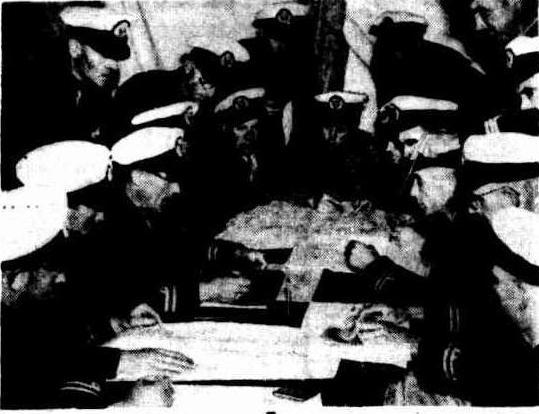
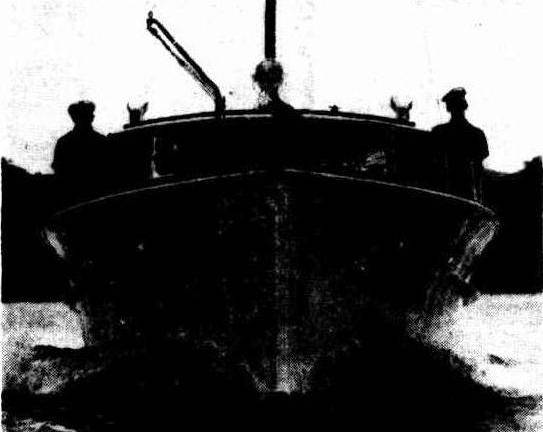
The New South Wales Volunteer Coastal Patrol, comprising motor-yacht owners who are learning auxiliary naval work is undergoing a week's training at Pittwater. More' than 100 members are in camp Top-Skippers plotting their course on charts before going to sea. Lower -The motor-yacht Pelorus, one of the many fine craft patrol, leaving the training station for manouvres. NAVAL TRAINING FOR COASTAL PATROL. (1939, November 24). The Argus (Melbourne, Vic. : 1848 - 1956), p. 1. Retrieved from http://nla.gov.au/nla.news-article11286375
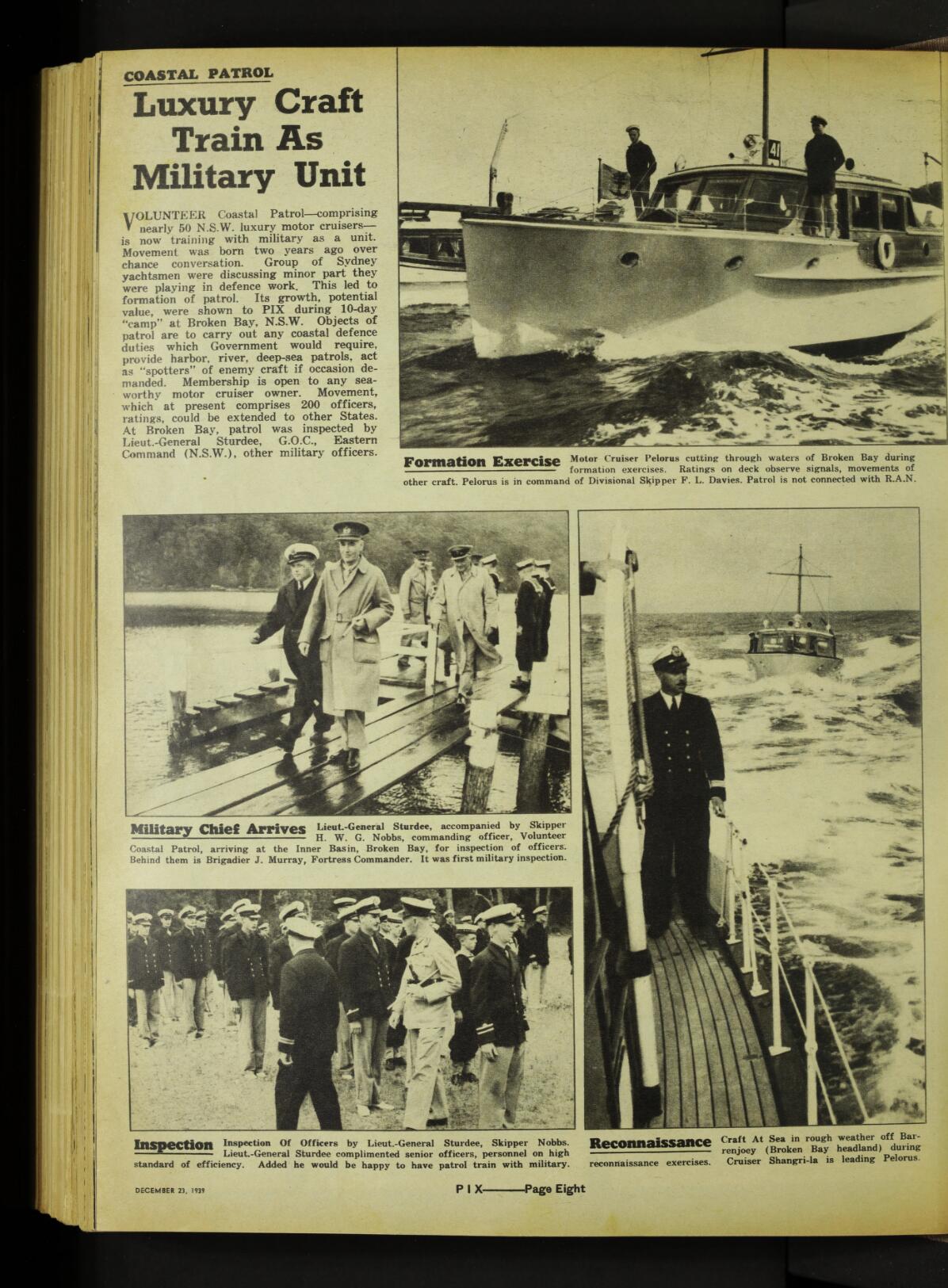

(1939). December 23, Pix, Volume 4, No. 26, pages 8-9. Retrieved from http://nla.gov.au/nla.obj-467076244
Frank Davies commissioned PELORUS from Halvorsens with the specification that it be strong enough to carry a gun on the foredeck. The motor cruiser was completed in 1939 and commandeered by the Royal Australian Navy during World War II for checking coastal defences. PELORUS went on to serve with the Volunteer Coastal Patrol and was used for police work and for assisting the Australian Army in the positioning of searchlights on beaches. It was later renamed PRINCESS NEVERFAIL.
In marine navigation, a pelorus is a reference tool for maintaining bearing of a vessel at sea. It is a "dumb compass" without a directive element, suitably mounted and provided with vanes to permit observation of relative bearings. Carl and Trygve Halvorsen were among the early members and the boat building family donated the use of its Neutral Bay boatshed for use as the VCP Depot ‘Seahorse’.
By June 1940, the Coastal Patrol had begun additional operations with the Army as part of the Newcastle/Port Kembla Covering Force under Major General Fewtrel including combined Invasion exercises with the 1st, 4th, 17th, and 45th Battalions between Port Hacking and Cape Three Point. In the Spring of 1941 another exercise was carried out in Pittwater:
"INVASION" OF N.S.W. COAST. Force Makes Inland But Is Repulsed SYDNEY, September 12. The invasion exercises carried out this morning on the shores of Broken Bay and in French's Forest have satisfied Army officers that an actual invasion of the New South Wales coast could be repulsed. Although the invading force, in theory, smashed the coastal defences at Broken Bay, managed a successful landing, and pushed several miles inland, the advance was halted when reserves were rushed up and it was eventually pushed back into the sea. The invasion exercise was the culmination of a week of manoeuvres in which the Navy, Army and Air Force took part, and which were devised to test the communications and co-ordination of the three services in the defence of the coast. An Army spokesman said today that manoeuvres had been entirely successful, and many valuable lessons had been learned. All the material collected during the exercises was being carefully studied by the defence chiefs. Residents of Palm Beach, Newport, Mona Vale and French's Forest awoke yesterday morning to find fully-armed soldiers guarding all the strategic points on roads. Early morning motorists and bus drivers found roads blocked with barbed wire and traps, and were challenged by dust-begrimed militia men These were the invading forces -carefully selected men of the 2nd Division, Home Defence Force—who had been landed before dawn—theoretically—from an enemy convoy and had overcome the local defenders. Covering Force Lands The 2nd Division men were taken into Broken Bay before dawn in a naval vessel and landed at three points in motor launches by the Naval Auxiliary patrol. They represented the covering force of an attacking brigade. The first party was landed at a jetty on the Pittwater side of Palm Beach. The members sprang into motor lorries which were waiting, and which represented armored fighting vehicles. They overcame and captured detachments of defenders until they reached Mona Vale, where there was a battle for the junction of the road from French's Forest. Without meeting opposition, the second party landed at Church Point and raced to the junction of the Church Point and Pittwater roads through French's Forest. The third landing party got ashore at Coal and Candle Creek, captured defenders there and overran a large part of Pittwater road. By dawn a great section of French's Forest and the coast from Mona Vale to Palm Beach was in occupation by the covering force of the invading troops. But their success was only temporary. Men of the 1st Division Militia were racing from a, big military camp in trucks, Bren-gun carriers and other fighting vehicles to French's Forest. The arriving defenders halted the advance and, as the reserves arrived, counter-attacks were made, and the invaders were gradually driven back. Artillery was brought upto shell the attackers out of strategic points. Because of the great amount of cover provided by the trees, the defending troops were able to carry put flanking movements to dislodge the invaders. "INVASION" OF N.S.W. COAST. (1941, September 13). The Advertiser (Adelaide, SA : 1931 - 1954), p. 6. Retrieved from http://nla.gov.au/nla.news-article44956820
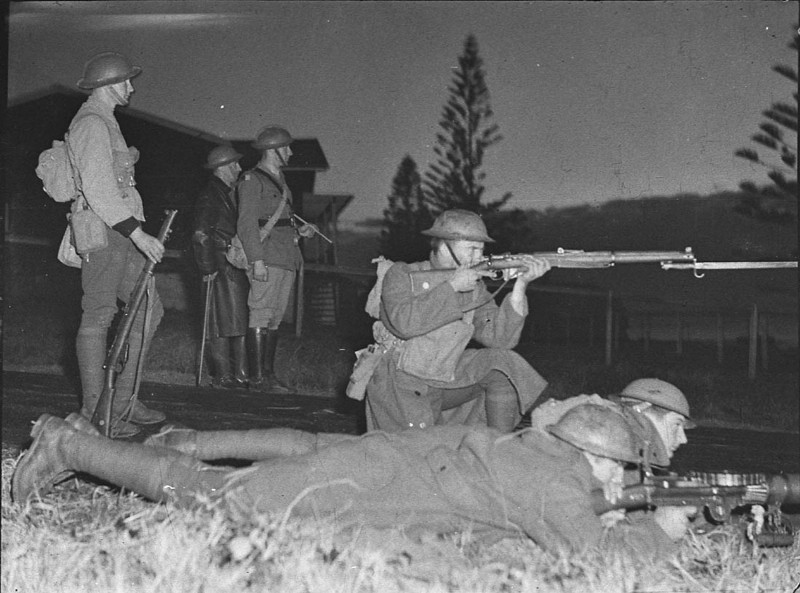
'Dawn attack at Mona Vale', date: 8/1938 (?),Image No: hood_18861 from Home and Away series, courtesy State Library of NSW.
Coastal Patrol was then requested to establish and maintain a security guard around the large troop ships, which began to operate from the port in April 1940. The Queen Mary was in port for several weeks to be converted from a luxury liner to a troop ship. At this stage, the defence boom had not been built and this lull before the storm was referred to as the ‘Phoney War’.
The Government declared that Coastal Patrol vessels and bases should wear the State Ensign in recognition of the work the Patrol was doing and the official capacity it now had. The Ensign was presented to the OC, Harold Nobbs in August 1940, at a formal ceremony at Killarney, a recreation area in Middle Harbour. The presentation was made by Police Superintendent Ferguson.
In NSW, where the Coastal Patrol maintained the port security of Sydney Harbour (wharves, oil installations, bridges and extremities), they were both Special Police Constables of the ‘Water Police Reserve’ and, as the 'Sydney Harbour Patrol’, held Warrants from the Maritime Services Board to enable them to board ships and wharf areas. All crew were required to carry side arms.
By 1941, the Patrol was operating in three States with over 2,000 members and 500 small ships. Manoeuvres were held at Clontarf in February of 1941, for extensive training in aircraft recognition and signalling.
In August 1941 a Naval Auxiliary Patrol was formed. While a total of 662 private boats were used, 87 NAP vessels were formally commissioned into the RAN. August 1941 was also when Captain Blackwood died.
NAVAL AUXILIARY PATROL. Enrolment Begins To-day. Enrolment of men and vessels for the Naval Auxiliary Patrol will begin in Sydney to-day. Units of the patrol are to be formed at ports around the whole coastline of Australia. Privately owned yachts motor vessels fishing boats and all types of suitable small craft will be enrolled for service in the New South Wales squadron of the patrol not only in Sydney but at all coastal towns. The squadron which is under the command of State Skipper P E Scrivener will be organised in flotillas of 32 vessels each. Each flotilla will comprise four divisions of eight vessels except at small ports where there may be a smaller number of vessels in a division.
Vessels will remain under the control of their owners who will be trained in seamanship navigation signalling and first aid. Volunteers for manning the craft aged between16 and 60 are required. Duties and training of the patrol will be carried out in spare time and valuable experience will be given to all personnel. A thorough syllabus of training has been approved by the Naval Board. Men with experience of handling fishing vessels and competent to carry out patrol work outside harbours are particularly sought. Offers of vessels and of personal service should be made to the headquarters of the unit Broughton House 181 Clarence Street Sydney between 2 30 and 6p m and 7 and 9pm each day. NAVAL AUXILIARY PATROL. (1941, August 18). The Sydney Morning Herald (NSW : 1842 - 1954), p. 4. Retrieved from http://nla.gov.au/nla.news-article17745092
BLACKWOOD. - August 26, 1941, at Prince of Wales Military Hospital, Randwick, Captain Maurice Blackwood, D.S.O., R.N., of Huon Park, Turramurra, beloved husband of Dorothea Blackwood, aged 58 years. (By request, no flowers.) Family Notices. (1941, August 28). The Sydney Morning Herald(NSW : 1842 - 1954), p. 14. Retrieved from http://nla.gov.au/nla.news-article17752068
For most of the war years the Coastal Patrol in NSW was based at Craig Nathan at Neutral Bay, once the home of Ben Boyd. They patrolled over 128,000 nautical miles, entailing over 393,600 man hours during the period 1938 to 1945.
Late in 1941, the Coastal Patrol’s aims were changed slightly:
- To encourage the volunteer services of yachtsmen and others interested in seamanship, to undergo a course of training so that their services would be of value to Australia as may be required. This gave the Coastal Patrol a wider term of reference to assist all authorities. These aims, incorporated into the first Constitution dated January 1955 - then widened in 1961 - remain in the present Articles to this day.
VOLUNTARY COASTAL PATROL Valuable Auxiliary Service MORE MEN AND BOATS NEEDED
BY A STAFF CORRESPONDENT
Under the guidance of the Royal Australian Navy, the Naval Auxiliary Patrol is taking a rapidly-increasing part in the defence of Australia. The New South Wales Squadron now operates from five important ports, with private vessels given freely to the service, and manned by experienced but honorary crews. Its unofficial motto is simply "Service Without Fireworks."
Although the Naval Auxiliary Patrol is not a fighting arm, it is based on the same things as Australia's fighting services: picked and trained personnel; equipment; planned and organised duties; and leadership and morale. The important point, so far as the personnel are concerned, is that they are all men ineligible to be called up for service under the Defence Act; that they are not obliged to serve, but have chosen to do so without payment. Their only return Is the knowledge that they are carrying out valuable work. In age they vary from 16 years to 60. In experience they vary from men who have sailed the seas and skies of the world to business man who have rarely set foot to decking. As long as they have the essentials-a love of ships and the sea and an anxiety to assist in Australian defence-they take their place in the patrol.
500 MEMBERS
Not all members, of course, are boat owners. Many gained their experience, or their living, in other people's craft. The membership list includes many former members of the Yachtsmen's Auxiliary and the Volunteer Coastal Patrol, but others have never before been in an organised movement of this kind. Because the Naval Auxiliary Patrol does not enrol men liable to be called, up for military service it includes no fit single men under the age of 35. and its members are in the main men of mature years, many of whom saw service in the Navy, the merchant marine, or the Air Force in the Great War. Many have decorations-about which nothing at all is said.
The patrol already operates from Port Jackson, Botany Bay. Wollongong, Broken Bay, and Newcastle, and is being organised in other outports. The Newcastle patrol is the most recently formed. Membership in New South Wales is now about 500, but if men come forward as they are needed to carry out the increasing duties of the patrol the number will increase, it is hoped, to 1000. Details of the equipment of the patrol cannot be disclosed, because it is considered unwise to show how strong a hand the service is holding. For instance, the number of vessels In the patrol in Australia cannot be given.
The members have already begun training and attend regular lectures by honorary instructors in seaman-ship, navigation, radio, first aid, signalling, and other essential subjects. The courses are modern and thorough. Signalling, for example, includes Morse code, semaphore, and Aldis lamp. Some of the instructors have had experience in air navigation; others acquired their skill in merchant and naval vessels. Young or elderly, patrol members have to go back to school in their spare time.
NIGHT PATROLS
The patrols work at night both inside harbours and out along the coast. Each boat has its fixed crew, and does one night of patrol work only before returning to the bottom of the roster to await its turn. This gives each member of the patrol an equal amount of practical training and disturbs as little as possible the home and business lives of crews. A standby boat is kept in service.
The patrol craft range in size from small boats to luxury cruisers and vessels up to l8 tons. In peace-time they served purposes as varied as the occupations of their owners. Some stretched out in top grade racing; others may have been seen filled with laughing people in the quieter reaches of our waters; on others fishermen bent their nets.
Part of the work of the Naval Auxiliary Patrol is described simply as "implementing the National Security Regulations." In port this entails keeping constant watch on wharves, storages, and harbour installations; supervision of ships in midstream to see that no unwanted persons are able to get on board; and always an eye to the shore for signals. Four people at least in Sydney owe their lives to patrol crews who fished them from the harbour, two of them having fallen unnoticed from passing passenger boats.
The most important aspect of the patrol's work at present is its co-operation with the Navy, which directs Its operations. The patrols, by carrying out much of ¡he routine work which normally would fall to the Navy, release younger men for other duties. The commodore in charge of Naval Establishments, Sydney, Commodore G. C. Muirhead-Gould, has realised its value, and has taken the lead in the development of the patrol in this State.
ARMY CO-OPERATION
Plans have been prepared also for co-operation with the Army, Exercises have already been carried out in conjunction with land forces at several towns along the coast. Other services include communication with forces in isolated places, and co-operation with garrisons.
Land stations are being established at points along the coast to permit communication between the patrol vessels at sea and the naval and army authorities on land. Men experienced in signalling, and others who would be willing to serve in these shore stations, are needed by the patrol. Their value in the event of an attack on Australia, and, indeed, the value of all the strong craft and trained men of the patrol, can easily be seen. The patrol is not intended, however, to assist one national service more than another. It is a unified service with an organised central control, and can be placed as needed to give help in an emergency. The patrol is ready to assist the sea, air, and land forces, including the National Emergency Services wherever possible. The discovery of a minefield, a raider at large, a shipwreck, a plane fallen into the sea, a harbour fire or any of the countless other possibilities of war-will see the patrol ready to rescue, warn, or merely watch and wait.
MORE MEN NEEDED
Another aspect of the work of the patrol in Australia is this: Off the coast of Britain thousands of fishermen and boatmen keep constant watch for mines, U-boats, and enemy surface ships and aircraft. They responded in hundreds to the call of Dunkirk. The number of small boats working off the Australian coast is comparatively few and the vigil has been undertaken as far as possible by the Naval Auxiliary Patrol. Like the Navy, which looms over it, the patrol does its work silently, and well. Men and boats are needed. The ideal position would be for just enough men to be enrolled to take charge of boats as they are obtained; but no one who feels that he could assist need hesitate to offer his services. VOLUNTARY COASTAL PATROL. (1941, November 27). The Sydney Morning Herald (NSW : 1842 - 1954), p. 8. Retrieved from http://nla.gov.au/nla.news-article17776100
Since its inception in 1937, the Coastal Patrol has been organised at all levels, from National Headquarters to individual Divisions, into two parallel arms; ‘Operations’ and ‘Administration’. For the first 17 years of its existence, successive Officers Commanding operated from a National Headquarters in Sydney were advised by two principal Staff Officers, (one for Operations and one for Administration). They personally established Patrol policy and directed the operations and administration of the Patrol’s individual Divisions, which, from first formation, have been the operational heart of the Patrol.
Based on the Royal Australian Navy’s original concept of the Patrol, “as a volunteer body of yachtsmen and others interested In seamanship who would undergo a course of training so that, with utilisation of their own owner-skippered boats, they could be of service to the Navy or Military in the event of any National emergency” at its formation, four owner-skippered boats formed a Division and 4 of these Divisions comprised a Flotilla under a Flotilla Skipper. Post-war, to meet the task outlined in Chapter 2, Divisions had to expand from a predominantly boating organisation into one with three arms; Marine Rescue Radio Bases, Rescue Boats, and Education in safe boating.
With peace and the return to recreational boating and the VCP turned its focus to boater education and civilian search and rescue. The first Patrol-owned boat was an ex-Naval cutter, Juno, which began service in 1947, primarily as a training vessel for new recruits.
Various donated, sponsored and purchased boats were acquired, including four Maritime Services Board pilot boats and later, self-righting Waveney and Arun lifeboats imported from Britain. Vessel and radio training progressively became more formalised and operations extended along the coastline, with 25 NSW divisions eventually providing a volunteer rescue service and marine radio watch from Cape Byron to Eden.
The Broken Bay Division was part of the original foundation organisation and was administered as part of the Sydney region command. In 1947, a separate division was set up known as the Broken Bay Division, with Skipper Ray Weingott as its first Divisional Commander, and was operated directly from the members' own private vessels.
Since then, the Division has operated from bases at Church Point, Royal Prince Alfred Yacht Club and Royal Motor Yacht Club. The Division moved to the Royal Motor Yacht Club, in 1992, who donated the use of two rooms as a Base. They, also, generously provided berthing facilities for rescue vessels along with other assistance. On 12th March, 2005, the Division moved to its own premises, acquired with the much-appreciated assistance of the Pittwater Council, within the grounds of the Bayview Boat Ramp. The wheelchair-friendly Base boasts a radio room, administration office, two bunk rooms, galley, and a large education/meeting room.
In 1954, the then Officer Commanding of the Coastal Patrol, Harold Nobbs, decided to make the Patrol’s organisation less autocratic and held elections by which all members of the Patrol could choose a representative National Council. This elected Council was to be responsible for dictating policy, determining uniforms to be worn, appointing the Officer Commanding and controlling the Patrol’s finances.
1954 also bears witness to the VCP and the RMYC at Broken Bay maintaining their dedication to all service peoples and their children. The article below is one of several in consecutive years of picnics for Legacy:
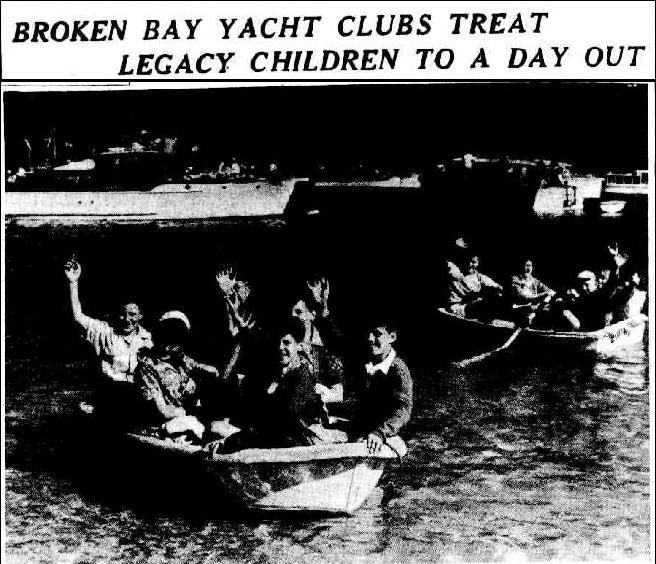 BROKEN BAY YACHT CLUBS TREAT LEGACY CHILDREN TO A DAY OUT.
BROKEN BAY YACHT CLUBS TREAT LEGACY CHILDREN TO A DAY OUT.
Some of the 1,064 Legatees after a picnic at Broken Bay yesterday wave farewell to their hosts. Members of the Royal Motor Yacht Club (Broken Bay),the Volunteer Coastal Patrol and the Kuring-gai Motor Yacht Club joined forces to treat the youngsters to a day out. They used 65 boats to take the children for a trip up the bay from Church Point. The appetites of 1,064 Legacy children at a picnic at The Basin, Pittwater, yesterday, astonished the organizers. The children demolished 6,000 bottles of soft drink.6,000 sandwiches and bread rolls, 6,000 cakes, and 2,000 pieces of fruit. The picnic was organised by the Legacy Club of Sydney, the Broken Bay branch of the Royal Motor Yacht Club, the Volunteer Coastal Patrol, and the Kuring gai Motor Yacht Club. The yacht clubs and the Volunteer Coastal Patrol provided the food and 70 cruisers to take the children from Church Point to The Basin and back. And 167 cars and buses were used to take the children from Legacy House, city, to Church Point and back. About 300 adults looked after the children. BROKEN BAY YACHT CLUBS TREAT LEGACY CHILDREN TO A DAY OUT. (1954, November 22). The Sydney Morning Herald(NSW : 1842 - 1954), p. 1. Retrieved from http://nla.gov.au/nla.news-article18449699
A 1957 incident:
Floating Mine Scare At The Entrance
SYDNEY, Sunday.—All shipping was to-night warned to steer clear of The Entrance because of a possible unexploded mine floating off Box Head. The object, which was described as "6ft. in diameter with horns," was first sighted by two fishermen.
The fishermen informed the Pittwater Volunteer Coastal Patrol, who sent a launch to investigate the object. They found it floating about one foot below the surface. Crew members of the launch believed it was an unexploded mine and informed police. A R.A.N. explosive crew was immediately sent by truck to Pittwater, where the launch was waiting.
The crew, however, arrived at Pittwater shortly before dark and it was decided to make a search of the area to-morrow. The Deputy Director of Shipping and Navigation has warned all vessels to keep clear of the area until the object has been identified. Floating Mine Scare At The Entrance. (1957, September 23).The Canberra Times (ACT : 1926 - 1995), p. 1. Retrieved from http://nla.gov.au/nla.news-article91238046
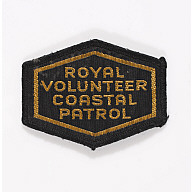 In 1963 the Patrol became an Incorporated Company registered in New South Wales with the Corporate Affairs Commission as a Company Limited by Guarantee under the Companies Act of 1961. It later became a Registered Charity. Registered Offices were established in all States of the Commonwealth. The Memorandum and Articles of Association of the Patrol were issued on 13th June, 1963
In 1963 the Patrol became an Incorporated Company registered in New South Wales with the Corporate Affairs Commission as a Company Limited by Guarantee under the Companies Act of 1961. It later became a Registered Charity. Registered Offices were established in all States of the Commonwealth. The Memorandum and Articles of Association of the Patrol were issued on 13th June, 1963
In a tradition continued by MRNSW, its members became a visible presence for major Sydney Harbour events, including royal visits, the opening of the Opera House, the start of the Sydney to Hobart Yacht Race, the 1988 Bicentenary and the 2000 Olympic Games, during which 88 volunteers gave more than 5,000 hours’ service.
Rehearsal Of Royal Tour Start.
A rehearsal of manoeuvres to control small craft on Sydney Harbour on February 3, when the Queen and Duke of Edinburgh arrive, will be held by the Volunteer Coastal Patrol at Broken Bay this morning. The State Director of the Royal Tour, Mr. P. H. Roper, announced this last night. About 35 motor and sailing craft, under the command of the officer commanding the Volunteer Coastal Patrol, Mr. H. W. G. Nobbs, would participate in the rehearsal. Mr. Roper said the Sydney Harbour Master, Captain D. McRae, would watch the rehearsal. He said that units of the Volunteer Coastal Patrol would co-operate with the Royal Australian Navy, R.A.A.F., and police to control the movements of many thousands of small boats on the day of the Royal landing. The Volunteer Coastal Patrol will assist in keeping unauthorised craft out of prohibited areas. These areas will be marked by 63 buoys which will not be placed in position until the day of the Royal arrival. Mr. Roper said: "The Royal Visit Committee anticipates that a great many craft from practically all the harbours and rivers along the New South Wales coast, as well as visiting craft from other States, will augment the Sydney contingent of craft. The latter will come from almost every slipway, every bay and cove in the Harbour." Mr. Roper added that among the actual participants in the pageant would be 380small boats forming a double banked laneway, through which the Royal barge would bring the Queen and the Duke to the landing pontoon in Farm Cove. Rehearsal Of Royal Tour Start. (1953, December 12). The Sydney Morning Herald (NSW : 1842 - 1954), p. 4. Retrieved from http://nla.gov.au/nla.news-article18400977
The Officer Commanding the Volunteer Coastal Patrol, Mr. Harold Nobbs, said last night that 40 Volunteer Coastal Patrol vessels would control between 4,000 and 5,000 small craft on Sydney Harbour on Wednesday. Nearly 200 men would man the patrol vessels. The mother ship of the patrol fleet would be the 48-foot cruiser Alberon. Mr, Nobbs said he would be in direct contact with all his patrol vessels from the Alberon by two-day radio. The patrol would start work on Wednesday at 4.15 a.m. and would be on duty in the harbour continuously until 10 p.m. SYDNEY'S BUSY WEEK-END. (1954, January 30). The Sydney Morning Herald (NSW : 1842 - 1954), p. 7. Retrieved from http://nla.gov.au/nla.news-article18407330
Locally you will see the Marine Rescue Broken Bay unit on the estuary every weekend and at ocean events such as the Ocean series of Pittwater Swims or the annual Lion Island Challenge, hosted by Avalon Beach SLSC.
In 1974 the Queen granted approval for the VCP to add the prefix “Royal” to its title. Recognising its funding and recruitment limitations, the RVCP keenly supported the transition to MRNSW. In 2019 only a South Australian presence remains, with two boat bases and seven radio bases.
By 1990 Operational Divisions of the Coastal Patrol had been established in all States of the Commonwealth except in Western Australia and the Northern Territory.
On 1st January, 2010, the Royal Volunteer Coastal Patrol, Australian Volunteer Coast Guard and Volunteer Rescue Association were unified into one organisation, Marine Rescue NSW.
During the years since its foundation, the Broken Bay Unit has provided the radio coverage and rescue facilities for the boating public in the area and assisted in the setting up of three other units as requirements grew. These other units are at Gosford, Hawkesbury and the Radio Centre at Terrey Hills (call sign 'Marine Rescue Sydney').
Members of the Unit also assist the local community by serving on various committees such as the Local Emergency Management Committee and various safety committees. The Unit is, also, available to be called out, by the local Emergency Management Officers, to assist in all community emergencies whenever it can help - even in non-marine situations.
It remains a 100% volunteer organisation and still operates Marine Rescue Radio Bases, Rescue Boats, and offers courses and Education in safe boating.
In 2012 alone they rescued or assisted 223 people.
The Broken Bay Marine Rescue, like all Marine Rescue Units, has an official motto which is also what they exhort us all to practice - the SOLAS convention - Safety of life at sea
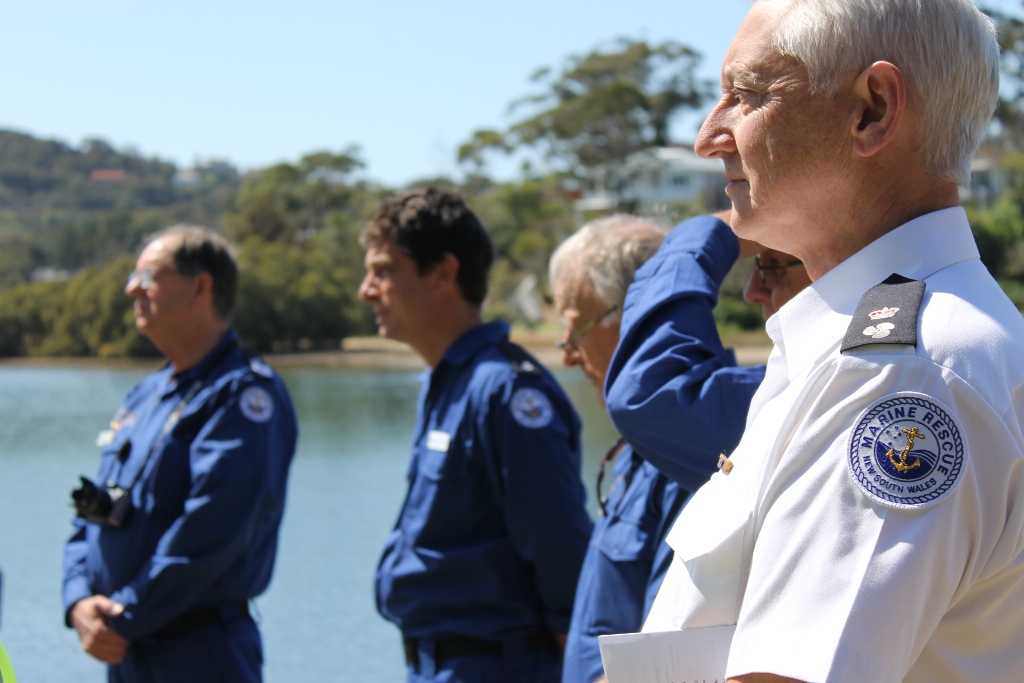
Broken Bay Marine Rescue Volunteers in 2012. Picture by A J Guesdon.
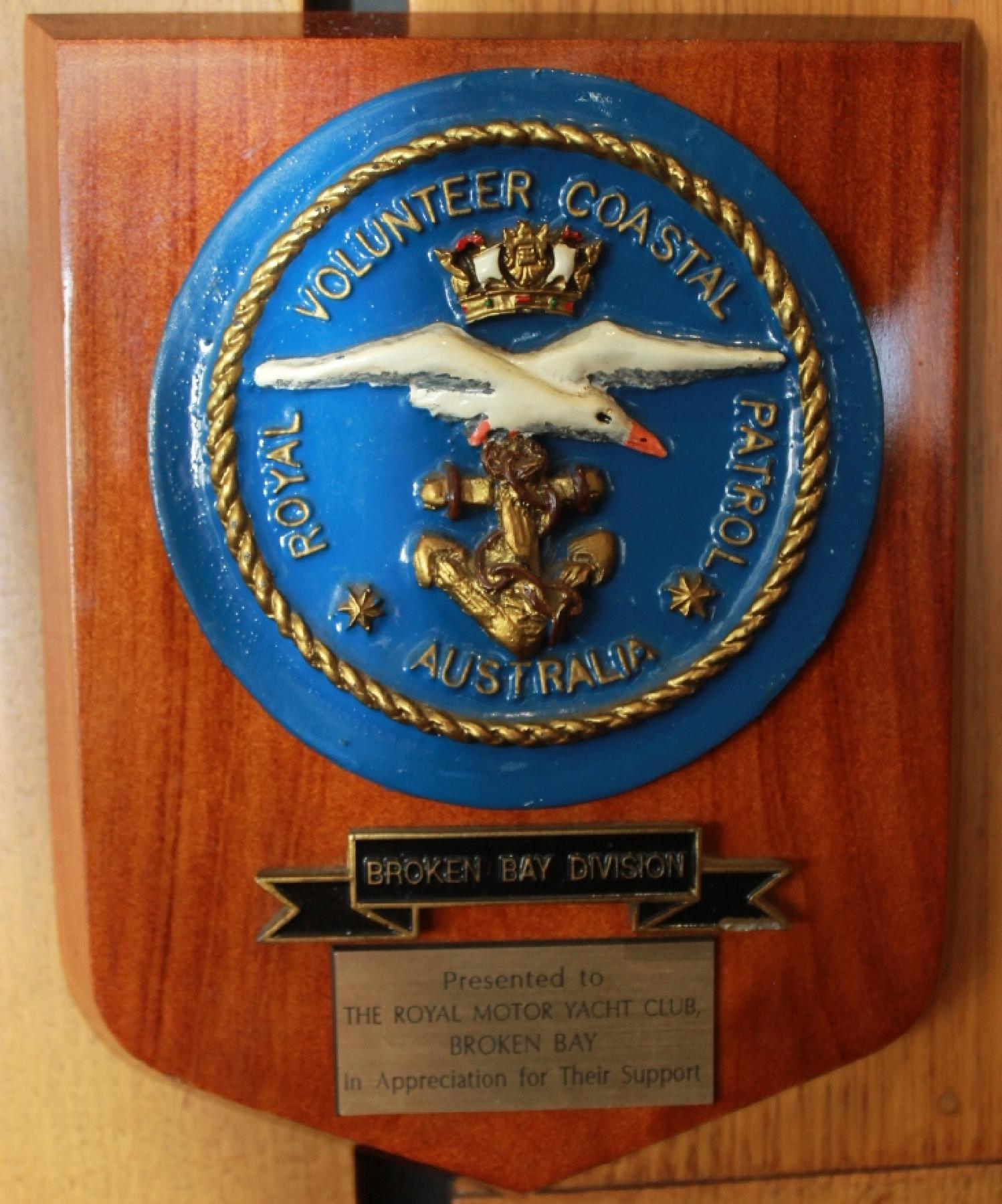
References
- Broken Bay Marine Rescue and Royal Volunteer Coastal Patrol History by and courtesy Barry J. McGrath, Captain Public Relations - Botany and MRBB.
- TROVE - National Library of Australia
- Volunteer Marine Rescue NSW: Broken Bay Unit Naming and Commissioning ceremony for New Wharf and New Lifeboat ‘BB20’ – ‘David B Harrison’
- New Marine Rescue Broken Bay Vessel Arrives
- The Royal Motor Yacht Club of Broken Bay Grand Opening of the 2012- 2013 Boating Season
- Prospector Powder Hulk At Towler’s Bay
- The First Naval Exercises By The New South Wales Colonial Ships – The Wolverene At Broken Bay In 1885
- Captain Francis Hixson - Pilot Service - Captain Cook
- The Fearless Men Of Palm Beach SLSC's Surf Boats First Crews : A Tale of Viking Ships, Butcher Boats and Robert Gow’s Tom Thumb 'Canoe'
- Naval Sea Cadets in Pittwater
- Broken Bay Water Police - History
- Broken Bay Marine Rescue - Royal Volunteer Coastal Patrol - History
- Royal Motor Yacht Club – Broken Bay – The Boat House and Boatshed (Second Clubhouse History)
- Royal Motor Yacht Club Broken Bay Clubhouses - First Clubhouse Part I
APPLICATIONS FOR LEASES FOR SPECIAL PURPOSES AND FOR EXTENSIONS OF TERMS OF SPECIAL LEASES.
IT is hereby notified, for general information, that the undermentioned applications have been received for leases for special purposes and for extensions of terms of Special Leases, under, the provisions of the 74th, 76th and 229th sections of the Grown Lands Consolidation Act, 1913, of the lands and for the purposes hereunder stated, and that it is the intention to grant leases should no sufficient objection be found to exist, after inquiry by the Land Board and consideration by the Minister.
Any objections will receive due consideration, if lodged in writing with the District Surveyor for the Land Board District in which the land is situated, on or before the date specified in each case hereunder.
B. T. BALL, Minister for Land.
Parish of Narrabeen, county, of Cumberland; Special Lease 27-30, Metropolitan, for wharf and slips. Land applied for; about 150 feet by about 10 feet below highwater mark fronting lot 6, Horse Shoe Cove, Pittwater. Applicant The Royal Motor Yacht Club of New South Wales (Broken Bay Branch). Objections may be lodged at the Land Board Office, Lands Department, Sydney, up to 19th December, 1927. s
Parish of Narrabeen, county of Cumberland; Special Lease No. 27-34, Metropolitan, for purpose of wharf. Land applied for about 14 perches below high-water mark fronting Lot 4, Beaconsfield-street, Pittwater. Applicant—Whitaker, Hayman and Co. Ltd. Objections may be lodged at the Local Land Board Office Sydney, up to 16th January, 1928.
Parish of Narrabeen, county of Cumberland; Special Lease No. 27-19, Metropolitan, for purpose of, boatshed. Land applied for about 10 perches below high-water mark opposite the end of a road or access reserve adjoining lots 53 and 54 of Forssberg's Estate, Barrenjoey-road, Pittwater. Applicant—Gillie Christian. Objections may be lodged at the Local Land Board Office, Sydney, up to 16th January, 1928. APPLICATIONS FOR LEASES FOR SPECIAL PURPOSES AND FOR EXTENSIONS OF TERMS OF SPECIAL LEASES. (1927, December 16). Government Gazette of the State of New South Wales (Sydney, NSW : 1901 - 2001), p. 5798. Retrieved from http://nla.gov.au/nla.news-article222998874
Sea- Cadets and Motor Yachtsmen
.jpg?timestamp=1605291894140)
NEW MOTOR CLUBHOUSE. A view from the new clubhouse of the Broken Bay branch of the Royal Motor Club of N.S.W., which was officially opened on Saturday.
THE NAVY'S CONGRATULATIONS. A handshake at the competition among Navy League Sea, Cadets for the Charles Fairfax Challenge Flag Reading- from the left the figures are: — Midshipman Hinchliffe, R. Fake (best-dressed 'long-rigged' boy), Mr. W. Hammers (officer of the day), and Chief Petty Officer Hopper (judge).
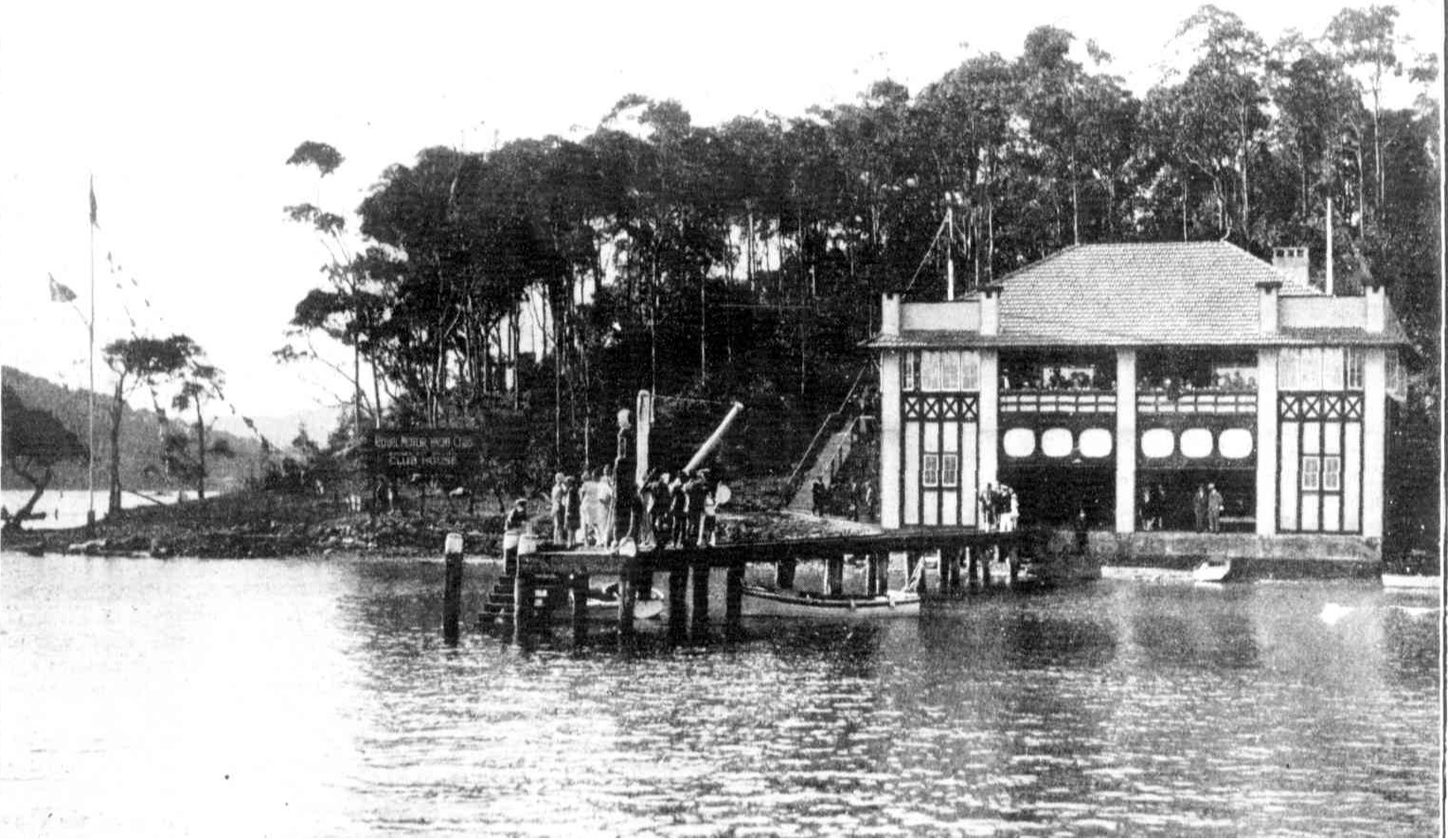
IN IDYLLIC SURROUNDINGS. The Broken Bay Motor Clubhouse, which was opened on Saturday as an adjunct to the Royal Motor Yacht Club of N.S.W. It is on Horseshoe Cove, in a setting of rare scenic grandeur, an imposing structure, attractively designed, and offering every comfort for members. The opening was performed with due regard to the ceremonial that the occasion demanded, and was accompanied by the firing of a salute of guns and the unfurling of flags.
.jpg?timestamp=1605291966407)
WINNERS OF THE CHARLES - FAIRFAX FLAG. The Birchgrove team of Navy League Sea Cadets, which scored highest in the contest in Sydney Domain on Saturday amidst keen competition, vieing with each other in squad drill, signals, knots, beads hitches splices, and other accomplishments of seafarers. Mosman was second and Balmain third. Sea-Cadets and Motor Yachtsmen (1928, March 21). Sydney Mail (NSW : 1912 - 1938), p. 10. Retrieved from http://nla.gov.au/nla.news-article158400568
PITTWATER TO HAVE NEW BURGEE
MR. ARTHUR WALKER, Branch Commodore of the Broken Bay Branch of the Royal Motor Yacht Club, will be the senior flag officer for the motor boats at the Pittwater regatta on December 30. He will head the parade of line astern cruisers and will fire a salute of eleven guns from his Lolita. Commodore Stuart Doyle, of the Royal Motor Yacht Club, will be on the flagship as president of the regatta to take the salute.
A beautiful new burgee has been adopted for the regatta. It is really the burgee of the Royal Burnham Yacht Club of England, and consists of a red St. George Cross superimposed on a blue St. George Cross with a white ground, and the letters P. and R. in the upper and lower canton.
500 Passengers
This will be flying from the flagship Gwydir. An attractive badge, comprising a flag design, has been also adopted. It is expected that 500 passengers will be aboard the flagship when she leaves at 7.30 a.m. on December 30 for the regatta. A parking area for cars has been prepared on the Hunter River Company's Wharf, so that drivers and their friends may motor down to the flagship and pick up their cars on its return. The tickets are: Men 5/, ladies and children 3/, and they may be obtained at the Company's Wharf or the State Theatre booking bureau. PITTWATER TO HAVE NEW BURGEE (1933, December 13). The Daily Telegraph (Sydney, NSW : 1931 - 1954), p. 2. Retrieved from http://nla.gov.au/nla.news-article247161102
Founded 1895 and receiving Royal Patronage in December 1927, the Royal Burnham Yacht Club is at the heart of sailing and related activities on the River Crouch.
Worth noting - Further extensions of RMYC BB and RPAYC
Sydney, 21st August, 1959.
OBJECTION TO SPECIAL PURCHASE AND PERMISSIVE OCCUPANCY
IT-is hereby notified that the undermentioned applications have been lodged. All objections should be accompanied by a deposit of £10, and lodged with the Metropolitan District Surveyor at Sydney on or before the 18th September, 1959.
W. J. BROADFOOT, Under Secretary for Lands.
Land District—Metropolitan; Shire-—Warringah
Parish Narrabeen, county Cumberland, Special Purchase 1957-79, for authority to reclaim and purchase an area of about 1 acre (in three parts) below high-water mark at Pittwater fronting lot 31, d.p. 5,193; and for a Permissive Occupancy for the purpose of dredging an area of about 1 acre 3 roods in Crystal Bay to obtain material for filling and provide for marinas; applicant, The Prince Alfred Yacht Club. Ten. 57-8,921. OBJECTION TO SPECIAL PURCHASE AND PERMISSIVE OCCUPANCY (1959, August 28). Government Gazette of the State of New South Wales (Sydney, NSW : 1901 - 2001), p. 2628. Retrieved November 7, 2020, from http://nla.gov.au/nla.news-article219941955
Sydney, 26th February, 1965.
OBJECTIONS TO SPECIAL PURCHASES
APPLICATIONS have been made to reclaim and purchase the areas particularised below. Any objections, accompanied by a deposit of £10, may be lodged with the Metropolitan District Surveyor, Sydney, on or before 26th March, 1965.
W. J. BROADFOOT, Under Secretary for Lands.
Land District—Metropolitan; Shire—Sutherland
Parish Sutherland, county Cumberland, Special Purchase 1963/60, of about 34 perches below high-water mark of Gunnamatta Bay adjoining lot 4, D.P. 217,396; applicant, Joseph James Bosley. Ten. 64-4,709.
Land District—Metropolitan; Shire—Warringah
Parish Narrabeen, county Cumberland, Special Purchase 1961/47, of about 1 acre 2 roods 36 perches below high-water mark at Pittwater adjoining lots 5, 6 and 7, section 1 of D.P. 4,689; applicant, The Broken Bay Club House Limited (Royal Motor Yacht Club—Broken Bay Branch). Ten. 64-3,385. OBJECTIONS TO SPECIAL PURCHASES (1965, February 26). Government Gazette of the State of New South Wales (Sydney, NSW : 1901 - 2001), p. 607. Retrieved from http://nla.gov.au/nla.news-article220356801
Article by A J Guesdon, 2020.